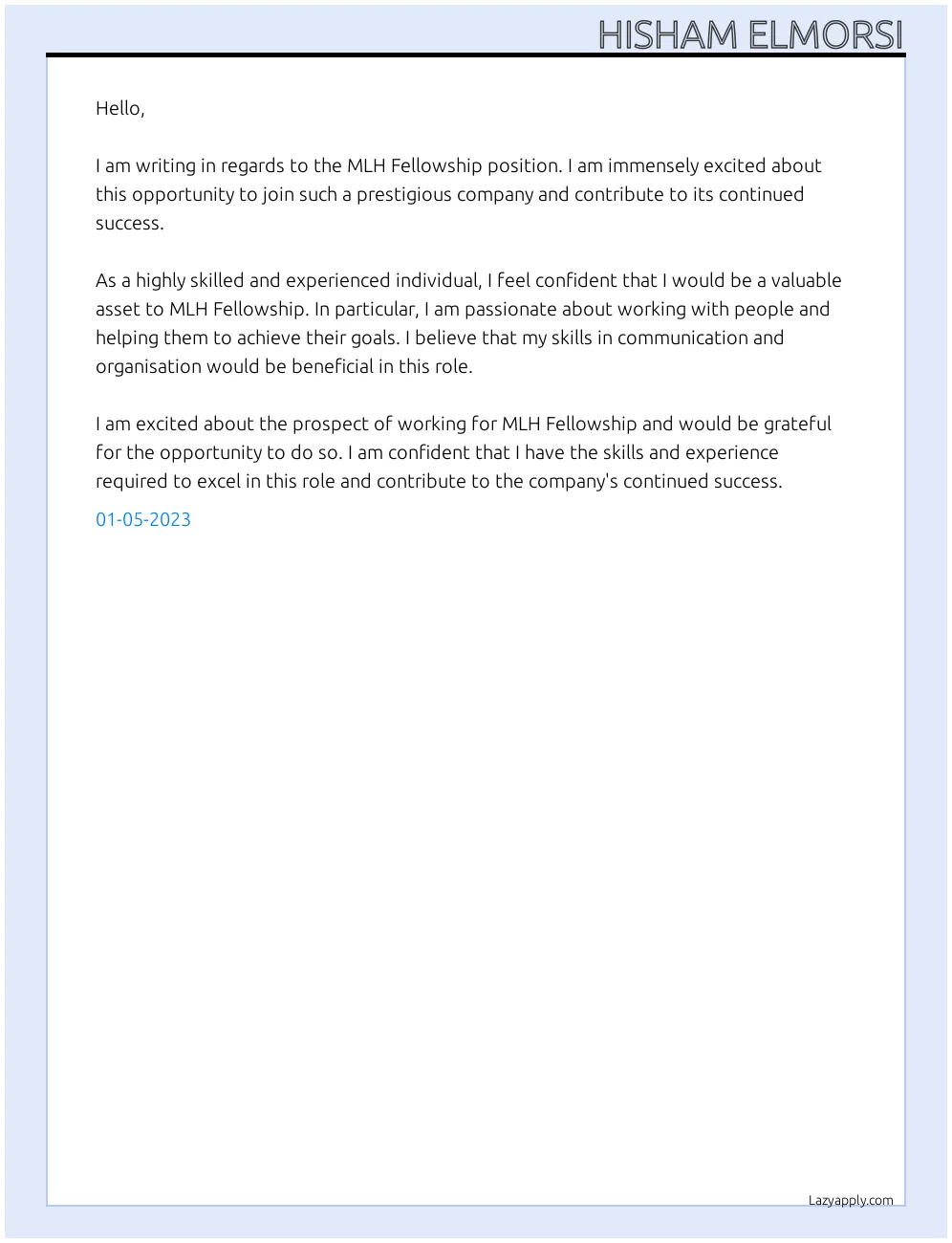Crafting the Perfect Fellowship Application Cover Letter
A compelling fellowship application cover letter is your first chance to make a strong impression and secure your dream opportunity. Unlike a resume, which provides a snapshot of your experience, a cover letter allows you to tell a story, connecting your past achievements to the fellowship’s goals. This comprehensive guide will unveil the secrets to writing a cover letter that captivates the selection committee and sets you apart from the competition. We’ll explore everything from the initial research phase to the final proofreading, ensuring your application shines.
Understanding the Purpose of a Cover Letter
The primary function of a fellowship application cover letter isn’t simply to repeat your resume. It’s a persuasive tool. Think of it as a narrative that demonstrates your genuine interest in the fellowship, explains why you’re an ideal candidate, and shows how your skills and experiences align with the program’s objectives. It is your opportunity to connect your personal story with the fellowship’s mission. This connection should be clear throughout your letter, resonating with the selection committee and making them more likely to consider your application favorably.
Highlighting Your Skills and Qualifications
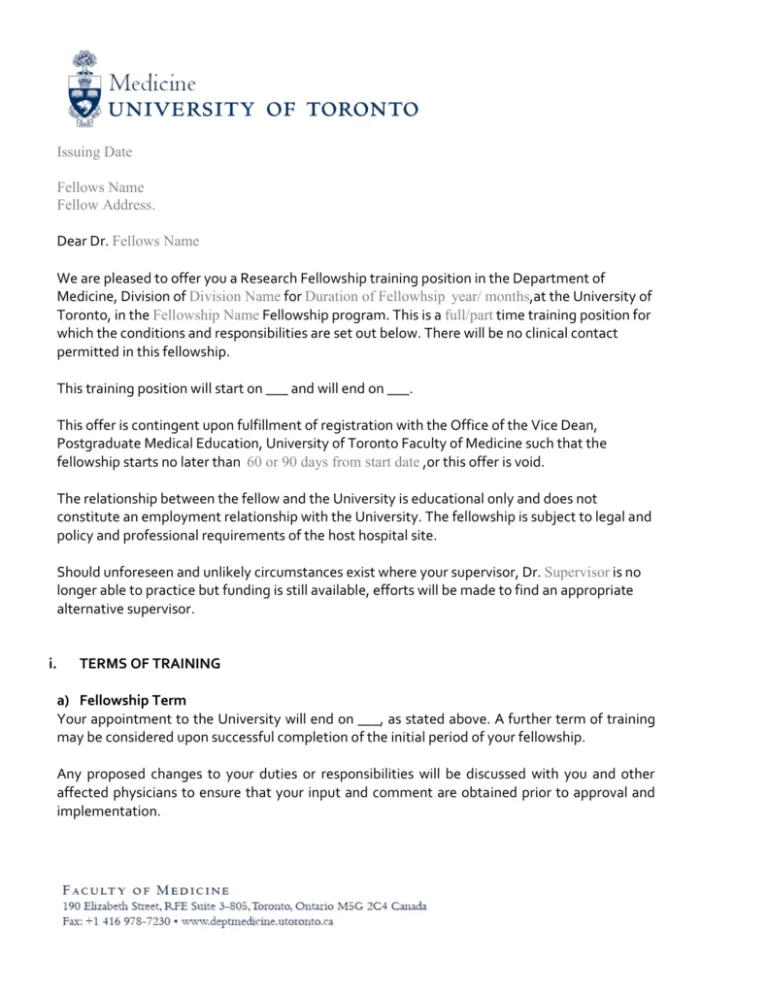
Your cover letter provides a platform to showcase your skills and qualifications beyond what’s listed in your resume. Start by identifying the key skills and experiences the fellowship values. Then, craft concise and impactful statements that demonstrate how you’ve utilized those skills in the past. For example, instead of saying “I have leadership skills,” provide specific examples of how you’ve led teams or projects, quantifying your achievements whenever possible. This approach allows the reader to better understand your suitability for the fellowship.
Researching the Fellowship and the Organization
Thorough research is the foundation of a successful cover letter. Before you start writing, delve deep into the fellowship’s mission, values, and goals. Visit their website, read publications by current or past fellows, and understand the specific requirements of the program. This knowledge is crucial for tailoring your letter effectively. Knowing the organization’s current priorities will enable you to align your qualifications and experiences directly with their needs, showing that you are not only qualified, but also a well-informed and enthusiastic candidate.
Tailoring Your Letter to the Specific Fellowship
Generic cover letters are easily spotted and rarely make a lasting impact. Each fellowship is unique, and your cover letter should reflect that. Avoid using a template without significant customization. Carefully analyze the fellowship’s description to identify the skills and experiences they prioritize. Then, use this information to emphasize the relevant aspects of your background, highlighting how your contributions align with their specific objectives. Personalized cover letters demonstrate your commitment and increase your chances of getting noticed.
Key Components of a Fellowship Cover Letter
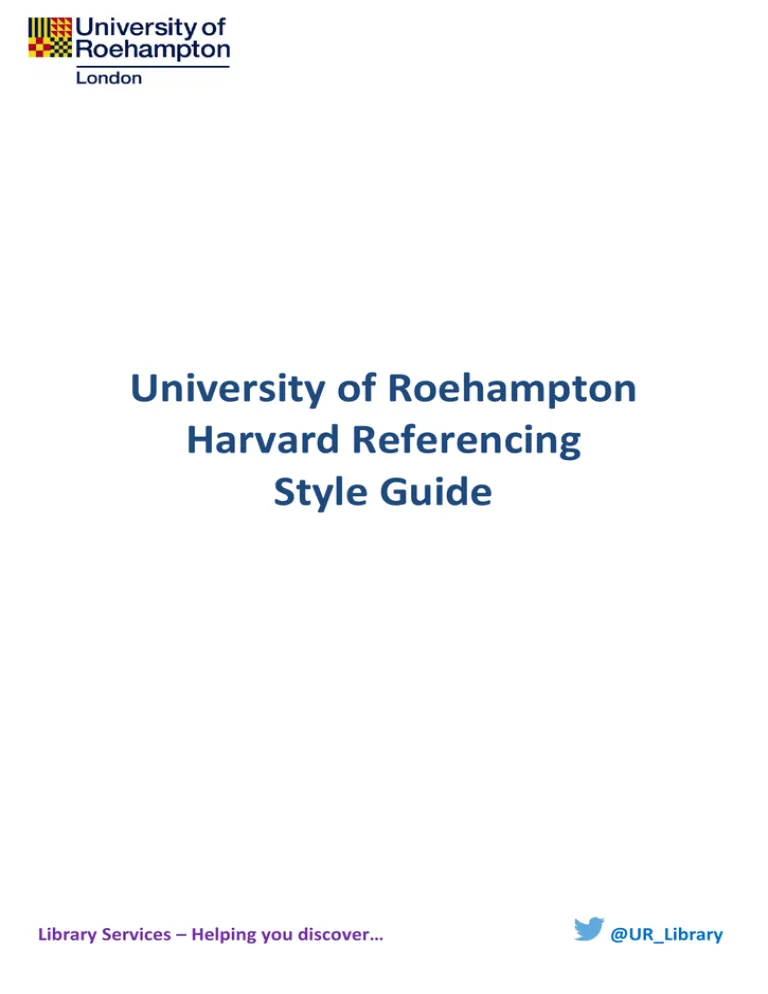
A well-structured cover letter follows a standard format. This ensures clarity and allows the selection committee to quickly find the information they need. The key components include the header, salutation, introduction, body paragraphs, closing paragraph, and your signature. Each section plays a vital role in making your application stand out. By understanding the purpose of each section, you can create a cohesive narrative that highlights your qualifications and motivates the reader.
Header and Contact Information
Your header should include your full name, address, phone number, and email address. Ensure your email address is professional and easy to read. The header also includes the date, and the recipient’s name, title, and address. Always address the letter to a specific person if possible; this shows you’ve done your research and demonstrates your attention to detail. Double-check the accuracy of all information before submitting, as errors can create a negative impression.
The Salutation and Introduction
Start your letter with a professional salutation, such as “Dear Dr. [Last Name]”. If you don’t know the recipient’s name, “Dear Fellowship Committee” is acceptable, but always try to find a specific contact. Your introduction should immediately grab the reader’s attention. Briefly state the fellowship you are applying for and, in one or two sentences, explain why you are a good fit. This section sets the tone for the rest of the letter, so make it engaging and enthusiastic.
Body Paragraphs: Showcasing Your Value
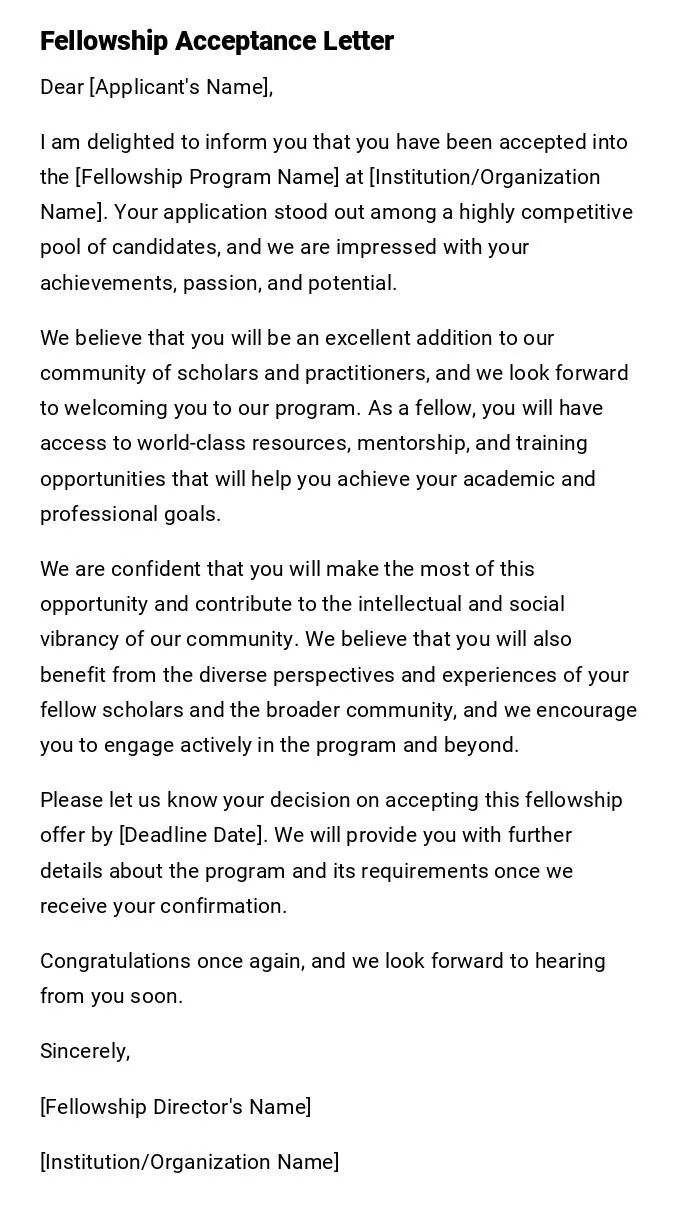
The body paragraphs are where you demonstrate your value to the fellowship. Use these sections to highlight your relevant experiences, skills, and accomplishments. Instead of simply listing your responsibilities, focus on what you achieved. Quantify your accomplishments whenever possible; for example, instead of saying “Managed social media accounts,” say “Increased social media engagement by 30% in six months.” Each paragraph should clearly relate back to the requirements and objectives of the fellowship.
Highlighting Relevant Experiences
Choose experiences that directly relate to the fellowship’s goals and your application. For each experience, describe your role, the challenges you faced, and the outcomes of your actions. Provide specific examples and data to support your claims. This information shows that you understand the responsibilities associated with the fellowship, and your achievements have prepared you for success. Remember to tailor your examples to the specific fellowship requirements.
Demonstrating Your Passion and Motivation
A genuine interest in the fellowship is essential. Convey your passion by explaining why you are drawn to this opportunity. Discuss your long-term goals and how the fellowship will help you achieve them. Share any personal stories or experiences that have fueled your interest in the field. Let the selection committee see your enthusiasm for their mission.
Linking Your Skills to the Fellowship Goals

Explicitly connect your skills to the fellowship’s objectives. Explain how your qualifications will contribute to the program’s success. If the fellowship emphasizes teamwork, describe your experience working collaboratively. If it values research, highlight your research skills and accomplishments. This connection demonstrates your understanding of the fellowship and ensures the selection committee understands how your capabilities will benefit their program.
The Closing Paragraph and Call to Action
Your closing paragraph should reiterate your interest in the fellowship and thank the selection committee for their time and consideration. End with a clear call to action, such as expressing your eagerness to discuss your application further. This demonstrates your proactive attitude and reinforces your commitment to the opportunity. A strong closing paragraph leaves a lasting positive impression.
Proofreading and Editing Your Cover Letter
Proofreading is a critical step that often gets overlooked. Carefully review your cover letter for any grammatical errors, typos, or formatting inconsistencies. A polished cover letter demonstrates your attention to detail and professionalism. Consider asking a friend, mentor, or career counselor to review your letter. An extra set of eyes can catch errors you may have missed.
Ensuring Clarity and Conciseness
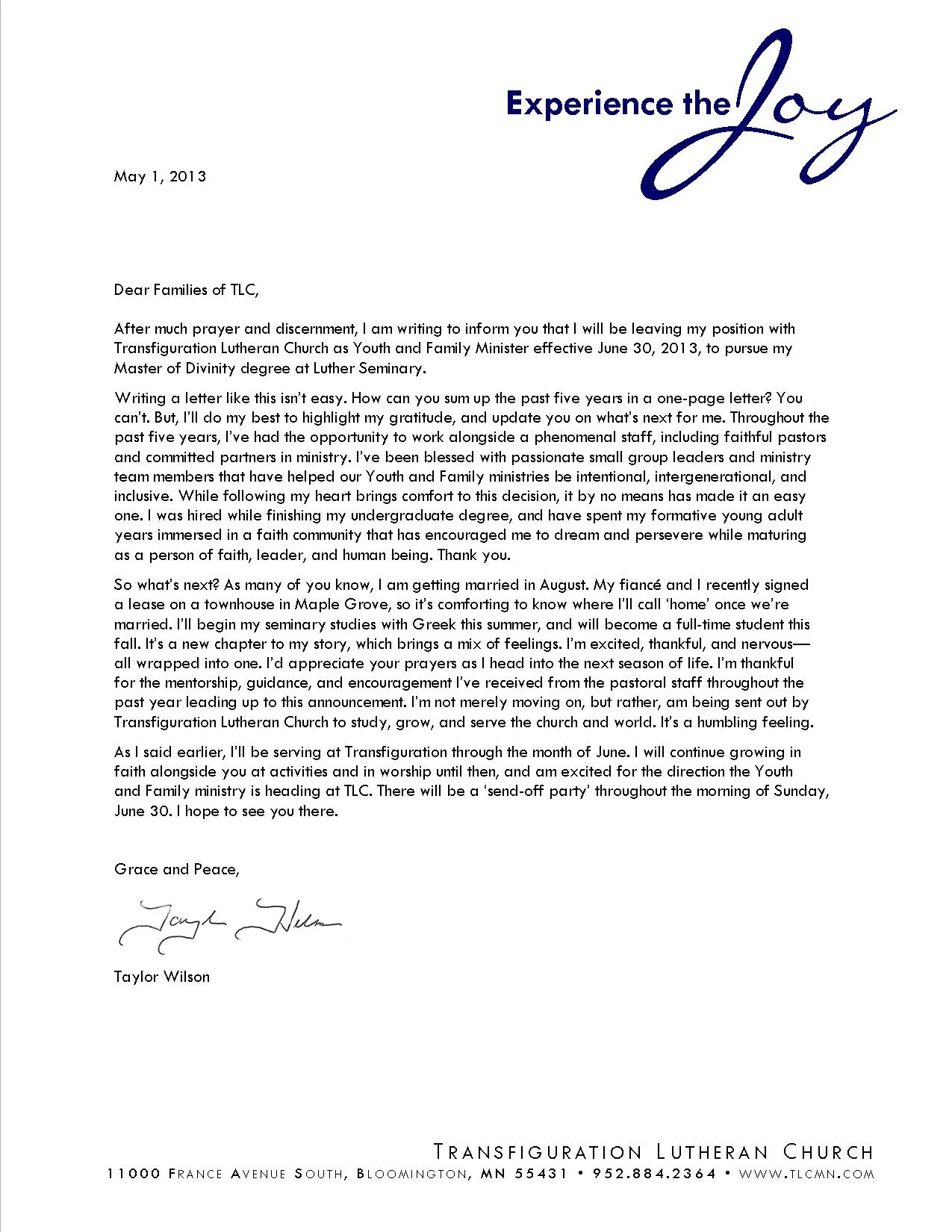
Keep your cover letter concise and to the point. Use clear and straightforward language, avoiding jargon and overly complex sentence structures. Each sentence should have a purpose, and every paragraph should contribute to your overall message. Aim for a letter that is easy to read and understand. A well-structured and concise letter shows respect for the selection committee’s time and enhances your application.
Avoiding Common Mistakes
Several common mistakes can weaken your cover letter. Avoid generic statements, such as “I am a hard worker.” Instead, provide specific examples of your hard work. Also, do not simply repeat your resume; use the cover letter to expand on your experiences and connect them to the fellowship’s objectives. Avoid mentioning salary expectations unless specifically requested. Always proofread your letter carefully to avoid grammatical errors and typos.
Using Strong Action Verbs
Action verbs make your cover letter more dynamic and engaging. Start your sentences with verbs that describe your accomplishments and skills, such as “Led,” “Managed,” “Developed,” “Implemented,” or “Achieved.” Using strong action verbs instantly communicates the impact of your actions and projects confidence. The reader can quickly understand what you accomplished by using dynamic action verbs.
Focusing on Achievements, Not Just Responsibilities
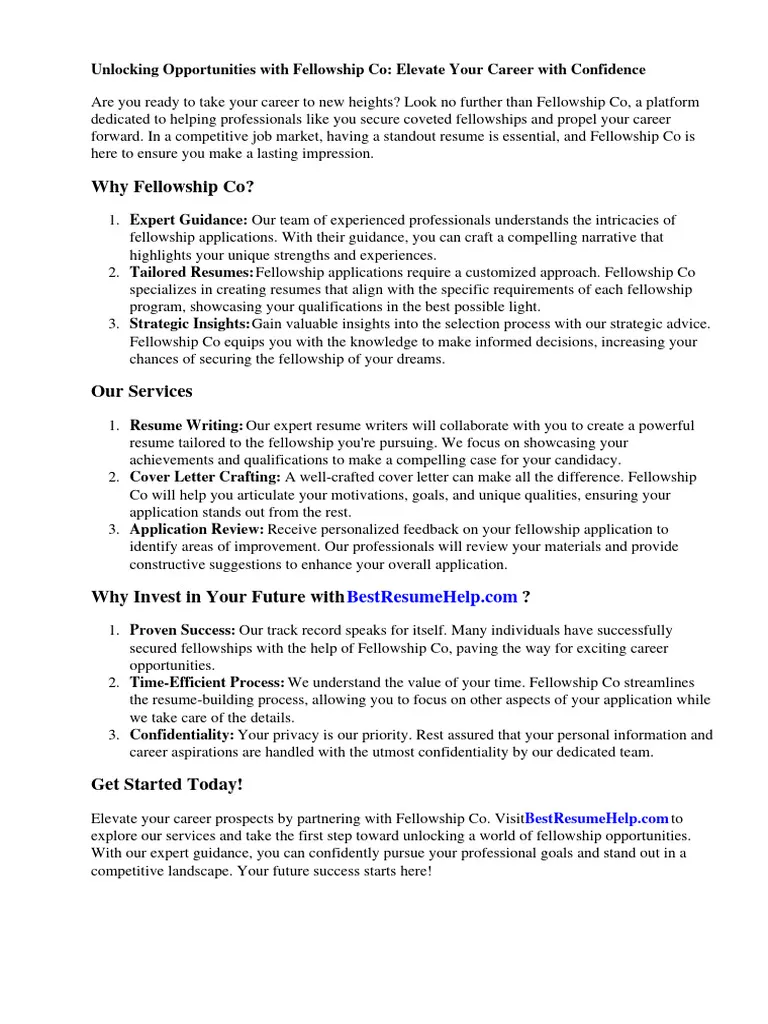
Focus on what you achieved in your previous roles instead of simply listing your responsibilities. Describe your accomplishments in detail, quantifying them whenever possible. For example, rather than saying “Responsible for managing social media,” state, “Increased social media engagement by 40% in six months by implementing a new content strategy.” Highlighting your achievements showcases your skills and creates a lasting impression.
Examples of Effective Cover Letter Phrases
Use phrases that clearly communicate your value and enthusiasm. For example, instead of saying “I am interested in this fellowship,” try “I am particularly drawn to this fellowship because…” Or, instead of saying “I have experience,” say, “My experience in [specific skill] has enabled me to…” Tailoring your letter with impactful phrases creates a favorable impact on the readers and leaves a great impression.
Formatting Your Cover Letter for Maximum Impact
The formatting of your cover letter is just as important as its content. A well-formatted letter is easy to read and visually appealing. Use a standard font, such as Times New Roman or Arial, with a font size of 11 or 12 points. Maintain consistent margins and spacing. Ensure your letter is visually appealing and easy to read to help you stand out.
Choosing the Right Font and Font Size
Select a professional font that is easy to read. Common choices include Times New Roman, Arial, and Calibri. Use a font size between 11 and 12 points to ensure your letter is legible. Avoid using unusual or overly stylized fonts that could distract from your message. Clear and concise typography improves the overall readability and professionalism of your cover letter.
Optimizing for Readability
Use clear formatting to enhance readability. Break up long blocks of text with paragraphs. Use headings and bullet points to highlight key information. Ensure sufficient white space between paragraphs. Make your cover letter easy to scan. Optimized readability helps readers easily understand your message and allows them to quickly grasp your qualifications and enthusiasm.
Submitting Your Cover Letter
Carefully follow the application instructions regarding the submission process. Always submit your cover letter as a PDF file to ensure your formatting remains consistent. This helps prevent potential issues with font changes or layout distortions. Double-check the file name to ensure it accurately reflects your name and the position you are applying for, making it easy for the selection committee to identify your application.
Following Application Instructions
Pay close attention to all instructions provided in the fellowship application guidelines. Failing to follow the instructions can negatively impact your application. Make sure you address all requirements of the cover letter, including the length, the specific content to be included, and any formatting preferences. By adhering to the instructions, you demonstrate your attention to detail and your respect for the selection committee’s process.
Additional Tips for Success
Beyond the essentials, consider these additional tips. Get feedback from trusted advisors, and always tailor your cover letter to the specific fellowship. Proofread your work multiple times and make sure your letter is grammatically correct. By investing time and effort in the application process, you significantly increase your chances of being selected for the fellowship.
